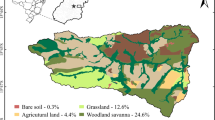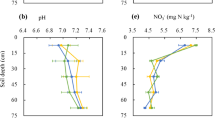Abstract
Riparian plants can use nitrogen (N) from soil and river water, but the use of river water N might be limited in higher floodplain environments of the Chikuma River. The purpose of this study is to reveal the relationship between N uptake by riparian plants and the floodplain topography (relative height and distance from a river channel). We examined the hypothesis that surface sediment removal from the higher floodplain increases river water N uptake by riparian plants by using a stable isotope analysis. The δ15N value of river water samples (ca. 8‰) were significantly higher than those of the soil extracts (ca. 3‰) in the study area. The δ15N value of riparian plants increased from +3.0‰ (standard deviation, SD ±2.1‰) before sediment removal to +9.6‰ (±2.1‰) after sediment removal, although there was no significant change in the δ15N value in N sources of soil and river water. The sediment removal enhanced frequency of flood disturbance, relative ground water level, and river water N uptake by riparian plants on the floodplain.





Similar content being viewed by others
References
Akamatsu F, Shimano K, Toda H, Okino T (2007) Nitrogen uptake by riparian plants in relation to topography along the Chikuma River, Japan. Ecol Civil Eng 10:191–198 (in Japanese with English abstract)
Bunn SE, Davies PM (2000) Biological processes in running waters and their implications for the assessment of ecological integrity. Hydrobiologia 422(423):61–70
Ikeuchi K, Kanao K (2003) The approach and the issue to conservation and restoration for river environment in Japan. Ecol Civil Eng 5:205–216 (in Japanese with English abstract)
Japan Meteorological Agency (2008) Climatic statistics. http://www.jma.go.jp/jma/index.html
Japan Society of Civil Engineers (2002) Hydraulics formulae: hydraulic worked example with CD-ROM
Kamisako M, Sannoh K, Kamitani T (2007) Does understory vegetation reflect the history of fluvial disturbance in a riparian forest? Ecol Res 22:67–74
Kohzu A, Matsui K, Yamada T, Sugimoto A, Fujita N (2003) Significance of rooting depth in mire plants. Ecol Res 18:257–266
Marston RA, Girel J, Pautou G, Piegay H, Bravard JP, Arneson C (1995) Channel metamorphosis, floodplain disturbance, and vegetation development: Ain River, France. Geomorphology 13:121–131
Ministry of Land, Infrastructure, Transport and Tourism, Japan (2008) Water information system. http://www1.river.go.jp/
Muranaka T, Ishii J, Miyawaki S, Washitani I (2005) Vascular plants to be designated as invasive alien species according to the invasive alien species act of Japan. Jpn J Conserv Ecol 10:19–33 (in Japanese with English abstract)
Nakamura F (1995) Forest and stream interactions in riparian zone. Jpn J Ecol 45:295–300 (in Japanese with English abstract)
Nilsson C, Jansson R, Zinko U (1997) Long-term responses of river-margin vegetation to water-level regulation. Science 276:798–800
Osugi T, Tate S, Takemura K, Watanabe W, Ogura N, Kikkawa J (2007) Ecological research for the restoration and management of rivers and reservoirs in Japan. Landsc Ecol Eng 3:159–170
Pinay G, Gumiero B, Tabacchi E, Gimenez O, Tabacchi-Planty AM, Hefting MM, Burt TP, Black VA, Nilsson C, Iordache V, Bureau F, Vought L, Petts GE, Décamps H (2007) Patterns of denitrification rates in European alluvial soils under various hydrological regimes. Freshw Biol 52:252–266
Pinay G, Ruffinoni C, Fabre A (1995) Nitrogen cycling in two riparian forest soils under different geomorphic conditions. Biogeochemistry 30:9–29
Power ME, Dietrich WE (2002) Food webs in river networks. Ecol Res 17:451–471
Swanson FJ, Gregory SV, Sedell JR, Campbell AG (1982) Land–water interactions: the riparian zone. In: Edomonds RL (ed) Analysis of coniferous forest ecosystem in the western United States. Hutchinson Ross, Pennsylvania, pp 267–291
Tabacchi E, Correll D, Hauer R, Pinay G, Tabacchi-Planty AM, Wissmar R (1998) Development, maintenance and role of riparian vegetation in the river landscape. Freshw Biol 40:497–516
Tamai N (2004) Principles in eco-compatible river basin management. University of Tokyo Press, Tokyo
Tockner K, Pennetzdorfer D, Reiner N, Schiemer F, Ward JV (1999) Hydrological connectivity, and the exchange of organic matter and nutrients in a dynamic river-floodplain system (Danube, Austria). Freshw Biol 41:521–535
Toda H, Uemura Y, Okino T, Kawanishi T, Kawashima H (2002) Use of nitrogen stable isotope ratios of periphyton for monitoring nitrogen sources in a river system. Water Sci Technol 46:431–435
Washitani I (2001) Plant conservation ecology for management and restoration of riparian habitats of lowland Japan. Popul Ecol 43:189–195
Ward JV (1998) Riverine landscapes: biodiversity patterns, disturbance regimes, and aquatic conservation. Biol Conserv 83:269–278
Ward JV, Tockner K (2001) Biodiversity: towards a unifying theme for river ecology. Freshw Biol 46:807–819
Woolsey S, Capelli F, Gonser T, Hoehn E, Hostmann M, Junker B, Paetzold A, Roulier C, Schweizer S, Tiegs S, Tockner K, Weber C, Peter A (2007) A strategy to assess river restoration success. Freshw Biol 52:752–769
Yoneyama T (1987) Natural abundance of isotopes of carbon, nitrogen, oxygen, hydrogen, and sulfur in soils and plants. Jpn J Soil Sci Plant Nutr 58:252–268 (in Japanese)
Yoneyama T, Matsumaru T, Usui K, Engerlaar WMHG (2001) Discrimination of nitrogen isotopes during absorption of ammonium and nitrate at different nitrogen concentrations by rice (Oryza sativa L.) plants. Plant Cell Environ 24:133–139
Yoshimura C, Omura T, Furumai H, Tockner K (2005) Present state of rivers and streams in Japan. River Res Appl 21:93–112
Acknowledgments
We thank the Chikuma River Office of the Ministry of Land, Infrastructure, Transport, and Tourism, Japan, for their cooperation and research support. This study was supported by the River Ecology Research Group of Japan.
Author information
Authors and Affiliations
Corresponding author
Rights and permissions
About this article
Cite this article
Akamatsu, F., Shimano, K., Denda, M. et al. Effects of sediment removal on nitrogen uptake by riparian plants in the higher floodplain of the Chikuma River, Japan. Landscape Ecol Eng 4, 91–96 (2008). https://doi.org/10.1007/s11355-008-0046-3
Received:
Revised:
Accepted:
Published:
Issue Date:
DOI: https://doi.org/10.1007/s11355-008-0046-3




